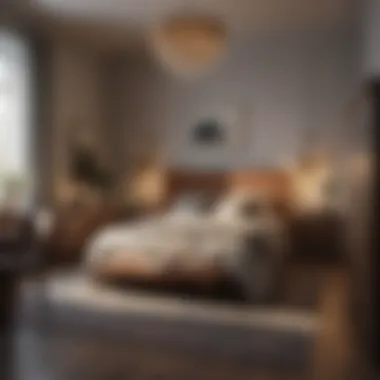Maximize Space: Smart Layouts for Small Bedrooms


Intro
When confronted with the task of arranging a petite bedroom filled with oversized furniture, one may feel a sense of dread. The sheer size of some furniture pieces can dwarf any room, making it seem even smaller. Nevertheless, transforming a cramped space into a cozy retreat is entirely possible with the right strategies. This article provides a comprehensive guide focused on navigating the nuances of arranging a small bedroom while still accommodating large furniture. We'll look into various design inspirations, dive into trending styles, and explore suitable color palettes that trick the eye into believing the space is more expansive than it truly is. Furthermore, it offers insightful tips on layout, decor choices, and practical organizational techniques crucial for achieving both functionality and a touch of elegance in those confined quarters.
Design Inspirations
Designing a small bedroom isn’t just about choosing furniture that fits; it’s also about how these pieces interact with the space around them. Using clever design inspirations can make a world of difference in creating an inviting atmosphere.
Trending Styles
Currently, several design trends cater specifically to maximizing space in small rooms. Consider adopting the following:
- Minimalism: This focuses on simplicity and the principle of ‘less is more’. Opt for furniture with clean lines and a substantial amount of empty space around it.
- Scandinavian Design: Known for its functionality and style, Scandinavian design emphasizes natural light, soft colors, and materials that create warmth, which can enhance the feeling of a bigger space.
- Mid-Century Modern: This style seamlessly blends form and function, allowing for oversized furniture that still feels light and airy, making it ideal for small rooms.
- Multi-Functional Spaces: Think about furniture that serves multiple purposes such as beds with storage underneath or folding desks that can be stowed away.
These styles not only promote efficient use of space but also bring an aesthetic appeal that can enchant anyone who steps foot into your bedroom.
Color Palettes
The colors you choose for your bedroom have a profound impact on how spacious it feels. Here are some suggestions to consider:
- Soft Neutrals: Light beige, creamy whites, and soft greys can create an expansive look. They reflect light effectively, brightening the atmosphere.
- Pastel Hues: Colors like mint green, lavender, or pale blue add a touch of gentle color without overwhelming the senses.
- Accent Walls: A single wall painted in a darker shade can add depth and create an inviting focal point without encroaching on the room’s overall spacious feel.
- Monochromatic Schemes: Sticking to varying shades of the same color helps create flow, making the small space feel less cluttered.
By carefully selecting a color palette, you can create a serene backdrop that allows your larger furniture pieces to shine without overwhelming the space.
"A well-chosen color scheme can be the difference between a cramped feel and one of airy freedom."
Understanding Space Constraints
In the world of interior design, understanding space constraints is not just a matter of aesthetics; it’s fundamental to creating a home that feels both functional and inviting. When arranging a small bedroom with large furniture, this understanding becomes paramount. Small bedrooms can often feel cramped, but with thoughtful planning, even the biggest pieces can fit harmoniously into confined quarters.
A key element of addressing these space constraints is recognizing the dimensions of the room. A well-measured layout can transform perceptions of space, making it feel larger or more efficient. This articulates how dimensions interact with the size of your furniture, which will be explored further in the next subsection.
"The constraint is not the enemy; it's a guiding force in creativity and design."
Defining Small Bedroom Dimensions
For a bedroom to be classified as small, it typically falls below the standard 10x10 feet footprint. However, what’s small for one might be cozy for another. Dimensions like ceiling height, shape (like long and narrow vs. perfectly square), and placement of doors or windows can greatly affect how space is perceived. To best utilize a small bedroom, first draw out a scaled floor plan. This plan should note where the windows, doors, and any built-in features like closets are situated.
When defining your room’s dimensions, consider not only the floor space but also the vertical space. A higher ceiling provides options for vertical storage and can change the perception of how airy or constricted a room feels.
Challenges of Big Furniture
With large furniture, the challenge lies in balancing functionality with aesthetics. Oversized pieces, while often essential for comfort, can overwhelm or dominate a space. Think about a king-sized bed occupying nearly half of a 10x10 room. This scenario not only limits movement but can also block natural light, making the room feel closed in.
Some challenges to consider with big furniture include:
- Proportion: Does each piece complement the overall size of the room?
- Accessibility: Can you easily navigate around the furniture?
- Visual Weight: Dark or bulky items can visually weigh down a room, making it feel even smaller.
To tackle these challenges, one must often temper decisions by opting for pieces that might serve multiple functions. For instance, a bed with built-in drawers or a compact desk that can fold away works to maintain a sense of openness while also catering to needs. In short, truly understanding these challenges in conjunction with the room’s dimensions allows for strategic choices that maximize comfort while minimizing chaos.
Prioritizing Essential Furniture
When dealing with the constraints of a small bedroom, the selection and arrangement of essential furniture can make or break the flow of the space. Prioritizing essential furniture focuses on the key pieces that not only fit within the limited square footage but serve practical purposes without compromising on style. In a world where every inch counts, making thoughtful choices about furniture becomes paramount. Choosing items that come with built-in functionality can be a game-changer, achieving both form and function.
What’s the use of a pretty chair if there’s no room to actually sit in it?
Consider this: A bed, while obviously non-negotiable, may also benefit from a headboard with built-in storage, or perhaps a larger bed could be swapped for a well-designed daybed. This ensures that even your sleeping area contributes to maximizing storage and minimizing clutter.
Identifying Key Pieces
Identifying key pieces shouldn’t feel like searching for a needle in a haystack. Look to staple items first: the bed, dresser, and possibly a desk or seating area, depending on how you plan to use the room. Ideally, each of these items should have either dual purpose or unique design functionality that fits snugly in your layout.
Prioritize the following:
- Bed: Opt for something that can fit comfortably but is also visually lighter, like a platform bed with open space underneath.
- Dresser or Nightstands: Choose options that are tall rather than wide, allowing for better utilization of vertical space without overstuffing the floor.
- Chair or Bench: If you can swing it, a small, stylish bench at the foot of the bed can offer seating and storage, serving a dual role.
With a proper plan in place, it’s not just about placing furniture but also considering how it interacts with each other. A well-placed dresser might enhance accessibility to items without being in the way.
Functional vs. Aesthetic Value
In the battle between functional and aesthetic value, it’s vital to find a comfortable middle ground. While it’s tempting to go for visually stunning pieces that catch the eye, they may not always translate to efficiency in a compact space. Thus, each decision should strike a balance.
- Function First: Sometimes you’ll need to pull the trigger on something that prioritizes usability. A stylish nightstand can look great, but if it takes away from walking space or storage, it’s best to reconsider.
- Aesthetic Appeal: That said, do not shy away from engaging designs. A decorative mirror not only adds visual appeal but also creates a sense of depth – an illusion that the space is much larger than it is.


Ultimately, your choices will define the vibe of the bedroom. Don’t skimp on the personality – however, fit it in a way that enhances practicality. This doesn’t mean compromising style for function; rather it means being intentional about how each piece contributes to the overall harmony of your room.
Remember: Thoughtful selections lead to a space that feels uniquely yours while ensuring it remains functional and inviting.
By following these principles, you can cultivate a haven that respects space constraints without sacrificing your design dreams.
Optimal Furniture Placement Techniques
Arranging furniture in a tight space is like fitting together pieces of a jigsaw puzzle. The focus of this section is on optimal furniture placement techniques, which can prove to be the linchpin in achieving both style and efficiency in a small bedroom. By considering several key elements, you can create a space that feels open and organized, making the most of what you have.
Maximizing Floor Space
Every inch counts in a small bedroom, and that’s why maximizing floor space is crucial. Start by identifying pathways for movement; the bed shouldn’t block any doors or the flow between furniture pieces. For instance, placing a bed against the longest wall can free up additional floor space, allowing for clear and easy navigation around the room.
Consider furniture with legs; it allows for visibility of flooring and creates a sense of openness. For instance, a positioned bed with a raised frame can make the floor below feel like a continuation of your living space rather than a hindrance.
• Use a Murphy Bed: For those wanting flexibility, a Murphy bed can be folded up into the wall, doubling the usable floor area during the day.
• Furniture Arrangement: Place tall furniture against walls to maximize space in the center. Larger pieces can be consolidated into one part of the room, opening up the rest.
By prioritizing spacious pathways and choosing the right furniture, the room doesn't just look larger; it also feels more inviting.
Creating a Focal Point
Every small bedroom can benefit from a focal point that draws the eyes in, creating an overall cohesive look. Perhaps it’s a hefty headboard, or a remarkable piece of artwork right above the bed. The aim is to lead attention away from cramped corners and instead showcase one standout feature.
Utilizing texture through various materials can help achieve this too. A soft bedspread might contrast beautifully with a wood-textured wall, creating layers and depth in a limited space.
Remember that less can often be more. Emphasizing one point means that the surrounding area can be kept more minimalist, avoiding visual clutter. This makes the room feel less crowded.
Using Angled Placements
Sometimes pushing furniture against walls isn't the best option, especially in unusual spaces. Angled placements can be particularly advantageous for maximizing weak areas in a room. For instance, turning the bed at 45 degrees can create a more dynamic layout, allowing for other furniture pieces to also fit in unique arrangements without feeling boxed in.
Furthermore, using angled placements can encourage conversations, should the room serve dual purposes, like hosting guests. An armchair placed strategically can invite interaction rather than isolation, enhancing the livability of the space.
• Layered Rugs: Try a vibrant area rug under an angled furniture piece. It softens the look and demarcates space without constricting movement. • Sight Lines: Make sure that angled furniture still allows for easy sight lines across the room; it keeps the space feeling connected.
Incorporating Vertical Solutions
When space is at a premium, looking upward can pay off. Incorporating vertical solutions into your small bedroom not only maximizes usable area but also enhances the overall aesthetics of the room. Utilizing height creates an illusion of larger space, drawing the eye upwards and making the environment feel less cramped.
Think about it this way: in a small room, the floor is the most limited resource. Every piece of furniture takes up precious real estate, sometimes leaving you feeling boxed in. By focusing on vertical arrangements, home owners can create a balance that liberates floor space while still keeping essentials at hand.
Utilizing Wall Space
The walls of your bedroom are like a blank canvas waiting to be filled. One of the most effective utilization of wall space is through the integration of hooks, racks, or shelving units. These installations can hold anything from books and decor to clothing and accessories.
- Wall-Mounted Hooks: Perfect for hanging bags, hats, or even decorative elements.
- Shelving Units: These can be integrated above the bed or on sidewalls, holding picture frames or favorite reads.
- Art & Accessories: Use framed art or small mirrors at varying heights. These will not only draw attention upwards but will also add a touch of style.
By considering what can be stored or displayed on the wall, individuals can significantly mitigate the clutter that usually appears on surfaces. Wall space offers not just decorative opportunities, but also functional uses without interrupting the flow of the room. Not to mention, it helps in bouncing light around, making the place feel open.
Vertical Shelving Options
Vertical shelving is a game changer. Unlike traditional shelving which is spread out, vertical units take full advantage of the height of the room. They can be both functional and beautiful, serving as a statement piece without hogging the floor.
Here are a few effective vertical shelving options:
- Tall Bookcases: These can serve as libraries or display areas. Position one against a wall, and it can act as both storage and a decorative backdrop, effectively utilizing that awkward corner that often goes unused.
- Ladder Shelves: These are trendy and surprisingly space-efficient. The wider base offers stability while the ascending shelves utilize vertical space efficiently. Plus, they carry a minimalist aesthetic.
- Corner Shelves: If you've got a tight nook, corner shelves can turn an awkward space into a storage haven. They are particularly useful for small rooms where every inch counts.
When selecting shelving options, quality over quantity is key. Choose pieces that are sturdy and can hold the weight of your intended items, ensuring they fit the overall theme of your space.
Remember, making smart vertical space decisions can drastically change the dynamics of a small bedroom, turning tight quarters into a coherent, lived-in space.
Color Influence on Space Perception
The hues that fill a room do more than just please the eye; they have the power to shift perceptions of space, especially in a small bedroom furnished with large pieces. Color, at its core, establishes the mood of a space while also influencing how we perceive dimensions. When dealing with large furniture in compact spaces, the right color choices can create illusions, making the area feel more open and inviting. By harnessing color effectively, homeowners can significantly enhance the flow and functionality of their sleeping quarters.
Choosing Light Colors
Opting for lighter colors is like casting a spell to open up cramped quarters. Shades like soft whites, pale blues, and light grays tend to reflect light, which expands the atmosphere and gives the impression of a larger area. Imagine stepping into a small bedroom painted in a delicate pastel. The instant sensation of airiness, where walls seem to recede and ceilings appear higher, comes alive.
Here are several key points about light colors:
- Brightness Boost: Light colors can brighten up any room, particularly when they catch sunlight.
- Versatility: Lighter tones can serve as a blank canvas, harmonizing well with larger furniture pieces in darker shades.
- Calmness and Serenity: Softer colors often evoke tranquility, setting the perfect stage for rest and relaxation at the end of a long day.
Yet, caution is warranted: over-commitment to all-white or very light schemes can wash out an area, rendering it sterile. Therefore, one must find a balanced approach, mixing in a few darker accents to maintain warmth and personality in the design.


Accents to Enhance Depth
Just as an artist uses brushstrokes to evoke depth in a painting, homeowners can use accent colors to accomplish similar effects in a small bedroom. Darker hues can provide contrast that draws the eye, creates layers, and adds a bit of dimension to the overall aesthetic.
A well-placed navy blue pillow on a light gray bedspread or a charcoal accent chair against cream walls can create a focal point, anchoring your vision without consuming all the space. To optimize the interplay of light and shadow, consider these suggestions:
- Accent Walls: One dark wall amidst light decor can serve as a striking backdrop for combined larger pieces of furniture.
- Artwork and Decor: Darker frames or art pieces on light walls can turn a blank space into one full of character and intrigue.
- Bedding and Cushions: These accessories can introduce pop colors or deeper shades; finding the right balance is key.
"Using color to define space is not merely an exercise in aesthetics—it's a practical approach to elevating function and flow in our daily environments."
Decorating with Purpose
Decorating with purpose goes beyond mere aesthetics; it's about crafting an environment that truly resonates with how you live, especially in a small bedroom filled with large furniture. Every piece of decor, every color choice, and every accessory should serve a function while still contributing to the overall appeal. This focused curation can make your space feel intentional and harmonious rather than chaotic and congested.
Selecting Size-Appropriate Accessories
The first step in decorating with purpose is choosing the right accessories. In a small bedroom, oversized items can dominate a space, making it feel cramped. Instead, consider accessories that are proportionate to your furniture. For instance, if you have a large bed, go for smaller side tables or delicate lamps that won't compete for attention. Accessories like throw pillows or blankets can add warmth without overwhelming your space.
- Moderation is Key: Rather than multiple oversized pieces, think of one or two impactful accessories that complement the furniture.
- Layering Textures: Using diverse materials can add depth without taking up physical space. Imagine the feel of a soft wool throw against the sleek finish of a wooden bed frame.
Opting for multi-functional items can further enhance practicality. An ottoman that doubles as storage or a wall-mounted shelf can be stylishly designed yet functional. The aim is to create a sense of lightness in the room, allowing for easy navigation while showcasing your personal style.
Mirrors to Reflect Space
Mirrors can be a game changer in a small bedroom. They reflect light, creating a sense of openness that can be especially beneficial when dealing with bulky furniture. Placing a mirror opposite a window can maximize natural light, making the room feel brighter and more airy.
"A well-placed mirror can turn a tight space into a canvas of reflections, showcasing not just what's in the room but also the beauty of what lies beyond."
Here are some strategic ways to use mirrors:
- Focal Point: Choose a statement mirror that catches the eye. This can establish a focal point and can also add interest to your decor.
- Framing the View: A mirror framed with ornate details can draw attention and act as art, giving the illusion of a larger room while looking stylish.
- Reflecting Design Elements: Use mirrors to reflect other decorative items, like plants or artwork. This not only multiplies the visual interest but encourages a feeling of tranquility.
Effective Storage Solutions
In a world where city living often means compromising on space, finding ways to organize and store belongings efficiently becomes a key concern for many homeowners. Effective storage solutions not only help manage clutter in a small bedroom but also free up valuable space for larger furniture pieces. The right strategies can transform your small bedroom from a cramped area into a sanctuary that maximizes functionality while retaining a sense of style.
Understanding the importance of proper storage cannot be overstated. It’s about more than just stacking things away. Well-planned storage solutions can enhance the overall aesthetic of the room, making it feel more open and inviting. With clever organization, you can ensure that everything has its place without the relentless feeling of chaos.
Multi-Functional Furniture
When space is at a premium, multi-functional furniture becomes a lifesaver. Selecting pieces that serve multiple purposes can drastically reduce the clutter and make the best use of limited floor area. For instance, a bed with built-in drawers can offer a cozy sleeping space while providing essential storage for clothes or linens. Similarly, an ottoman that doubles as a seat and a storage container can keep items like blankets or books neatly tucked away, leaving the room feeling less cluttered.
Here are a few examples of multi-functional furniture:
- Sofa beds: Serve as both a sofa during the day and a bed at night for guests.
- Storage benches: These provide seating and space to stow away shoes or bags.
- Desks that fold away: Ideal for small workspaces that need to disappear when not in use.
Opting for these versatile pieces can dramatically change the dynamic of a small bedroom, ensuring every inch is utilized wisely.
Under-Bed Storage Creations
One often overlooked storage space is right under your bed. It’s an area just begging to be used effectively. By investing in under-bed storage solutions, you unlock additional space that is often wasted. You can use containers or drawers specifically designed to slide easily beneath your bed.
For instance, consider using shallow bins for seasonal clothing, extra bedding, or even out-of-season shoes.
"Using the space under the bed not only declutters visible areas but also creates a streamlined look that fosters a sense of calm."
Here are some options for under-bed storage:
- Rolling drawers: These make accessing items simple and quick.
- Vacuum-sealed bags: Great for saving space, especially with bulky items like comforters.
- Storage boxes: Clear containers can be particularly useful, as they allow you to see the items inside without pulling everything out.
By focusing on under-bed storage, you can keep your immediate area tidy and free from unnecessary distractions. Thus, allowing you to enjoy your small bedroom even with larger furniture occupying the main space.
The Role of Lighting
Light plays a pivotal part in any room, particularly in a small bedroom. It’s not just about being able to see; it’s about creating an atmosphere that feels open and inviting. The essence of good lighting can dramatically transform how we perceive our surroundings. When space is limited, shadows and dark corners can easily make a room feel cramped. Thus, understanding the correct lighting techniques can significantly enhance the aesthetic and functional value of your bedroom.
Besides, well-designed lighting can highlight the elegance of large furniture instead of allowing it to dominate the room physically and visually. Applying the right lighting solutions holds the key to expanding a small area virtually without moving a single piece of furniture.
Maximizing Natural Light
Natural light is a tremendous resource that often goes underutilized. When you can draw in as much daylight as possible, you create a more airy environment. Here are several techniques to increase natural light:
- Window Treatments: Use sheer curtains or blinds that can be pulled completely back during the day. This allows unobstructed light to flood the room.
- Strategic Furniture Placement: Ensure that large pieces do not block windows. For instance, placing the bed or dresser away from the window maximizes exposure.
- Light-Reflecting Surfaces: Consider incorporating mirrors. They don’t just add style; they can reflect light around the room, making it brighter and seemingly larger.


When the sun spills in, the colors of walls and furnishings are more vibrant, uplifting the mood of the space. It’s like opening a window not just to the outside but to possibilities.
Layering Artificial Light
When natural light is less abundant, strategic layering of artificial light becomes paramount. By using different types of light sources, you can create a balanced environment that compensates for any lack of sunlight. Here are some approaches to consider:
- Ambient Lighting: This is your general light source. Ceiling fixtures or floor lamps can provide an all-encompassing glow. Opt for bulbs that imitate daylight to keep the space feeling lively.
- Task Lighting: For activities like reading or working from bed, add focused light sources such as bedside lamps or wall sconces. These lights should be easy to control, allowing you to brighten only the areas you need.
- Accent Lighting: Use this type sparingly to highlight art pieces or decor elements. It adds depth to the room and can divert attention away from the large furniture that might feel imposing.
"Lighting can make or break a room. It marries functionality with atmosphere, especially in a tight spot like a small bedroom."
The goal is to harmonize these layers, creating an environment that shifts seamlessly between day and night. Different light sources create dynamics, imparting a spacious feel, and giving the room versatility for different moods and times of day. It is not merely about visibility; it is about creating a certain vibe—a cozy corner for reading, a lively space for conversations, or a tranquil spot for relaxation.
With appropriate attention to lighting, you can sculpt your small bedroom into a nook that cleverly feigns expansiveness and style.
Harnessing the power of light allows homeowners to enjoy not only a functional sleeping area but an aesthetically pleasing retreat that encapsulates their unique style.
Final Touches for Enhanced Ambiance
Creating a small bedroom with large furniture can sometimes feel like fitting a square peg into a round hole. It's not just about choosing the right pieces, but also about how those pieces feel and interact in the space. This is where the final touches come into play. These elements can transform an ordinary room into a cozy sanctuary, making the most of what you have while adding layers of comfort and style. Incorporating textiles and personal art can dramatically influence the vibe and functionality of your bedroom.
Incorporating Textiles
Textiles can breathe life into any room. These materials can range from bed linens to curtains, rugs, and throw pillows. Not only do they serve practical purposes, but they can also zen up a space and make it feel welcoming.
- Layering Fabrics: Consider using different textures to create depth. A soft velvet throw over a cotton duvet can add a touch of luxury without overwhelming the space.
- Color Coordination: Match or contrast textile colors with your larger furniture pieces to create a harmonious look. If your bed is a deep navy, opt for light-hued cushions to prevent the room from feeling boxed in.
- Functional Fabrics: Use curtains that block out light if your bedroom is prone to becoming too bright early in the morning. Not only do they serve a purpose, but they also add a cozy aesthetic that complements larger furniture.
Incorporating textiles effectively balances the big items and small details, lending a sense of warmth and homeliness.
Personalizing with Art
Art is more than just decoration; it is a reflection of your personality and can serve as a focal point in a small bedroom. Here’s how to go about it:
- Choosing the Right Art: Select artworks that inspire you, whether it’s a favorite painting, photography, or even prints that blend with your color scheme.
- Creating a Gallery Wall: By clustering multiple pieces of varying sizes, you can draw the eye upward, making the space feel taller while also filling barren wall space.
- DIY Artwork: If you're on a budget, consider creating your own artwork or framing sentimental items, like postcards from travels or children’s art. This gives the room a personal touch that high-street art can’t match.
Remember, the purpose of adding art is to make the room feel unique and personal. It can anchor the large furniture, providing more context to the overall decor.
"The final touches you choose can be the difference between a house and a home, providing warmth and reflection of who you are."
In summary, thoughtfully selected textiles and personal art not only enhance the ambiance of a small bedroom but also contribute significantly to the overall design narrative. Together, they create a unique environment that feels expansive and inviting.
Sustainability Considerations
As we navigate the nuances of arranging a small bedroom with oversized furniture, it’s essential to pull sustainability into the conversation. Embracing eco-friendly practices in home design not only contributes to a healthier planet but can also enhance the aesthetics and function of your space. Using sustainable materials helps minimize harmful environmental impacts, allowing each choice to speak volumes about our values.
In small bedrooms, where every inch holds significance, sustainability can alleviate clutter and create a more serene atmosphere. Consider how your choices can embody principles of sustainability; for example, selecting furniture made from repurposed or responsibly-sourced materials blends functionality with eco-consciousness.
Choosing Sustainable Materials
Identifying the right materials is crucial for those keen on sustainability when arranging their sleeping space. Here are several factors to keep in mind when making your selections:
- Natural Fibers: Opt for bed linens and decor made from organic cotton, linen, or wool. These materials are not only biodegradable but also often more durable than synthetic fabrics.
- Sustainably Sourced Wood: When it comes to larger pieces like beds or dressers, look for furniture made from reclaimed wood or certified by the Forest Stewardship Council (FSC), ensuring responsible harvesting and minimal waste.
- Low-VOC Paints: Choosing paints or finishes with low volatile organic compounds (VOCs) contributes to improved indoor air quality and reduces health risks, especially in small, enclosed spaces.
- Bamboo: This fast-growing plant is a prime candidate for furniture and accessories, as it’s renewable and can thrive without the use of pesticides.
- Recycled Materials: Products made from recycled metals or plastics offer unique design options while promoting waste reduction.
Utilizing sustainable materials fosters a calm and stylish environment without sacrificing performance or decor.
"Sustainable practices in bedroom design are like a breath of fresh air, both for you and for the planet."
Taking the time to make informed decisions can lead to a cozy and inviting space that aligns with your ethos of sustainability. A small bedroom, furnished well with eco-friendly choices, can travel far beyond mere functionality—it can become a refuge that showcases not just personal style but also a commitment to a better tomorrow.
Innovative Storage Hacks
In small spaces, especially bedrooms, the challenge of efficiently utilizing every nook and cranny can be an uphill battle. Innovative storage hacks not only help in keeping things organized but also play a crucial role in enhancing the overall appearance of your space. When dealing with oversized furniture, maximizing every bit of space becomes vital. Using clever solutions can turn less desirable areas into valuable storage points, which can significantly reduce clutter and contribute to a more serene living environment.
Benefits of Innovative Storage Hacks
- Enhanced Organization: By implementing unique storage solutions, you can keep essentials at arm's reach while minimizing visual chaos. This creates a more peaceful and enjoyable atmosphere.
- Space Optimization: Smart storage techniques can turn underutilized areas, like the under-bed or above-door spaces, into functional storage that doesn’t compromise your room's layout.
- Aesthetic Appeal: Creative storage can help hide clutter, making the space feel more open. A well-organized room can feel larger than it truly is, an illusion every small bedroom could benefit from.
Considerations for Innovative Storage Hacks
When embarking on storage improvements, it’s important to consider the following:
- Functionality: Does the storage system serve its purpose well? Every hack should enhance usability without hampering the flow of the room.
- Accessibility: Ensure items stored away are easy to access. If you find yourself rummaging through piles of stuff, it defeats the purpose.
- Style and Design: Choose storage solutions that align with your bedroom aesthetic. Attractive options like wicker baskets or decorative boxes can add to the decor while providing function.
"A cluttered space is a cluttered mind. Maximizing your storage can clear more than just physical space; it clears mental space too."
There are numerous ways to creatively maximize your storage. Fabrics, colors, and smart placements can all work wonders. By being resourceful and imaginative, even the smallest of bedrooms can become clutter-free sanctuaries.
Repurposing Everyday Items
Repurposing items you already own is one of the most effective ways to introduce storage without additional investment. Consider those everyday items cluttering your home.
- Old Suitcases: Stack them at the foot of your bed to store off-season clothes or shoes. They provide stylish storage while serving a vintage vibe.
- Unused Drawers: If you have spare drawers lying around, mount them on walls as open shelves. This approach is functional and adds a unique decorative touch.
- Wooden Crates: These can be transformed into makeshift nightstands or shelves. With a bit of paint, they're not only useful but also quite charming.
- Mason Jars: Perfect for organizing small items or even as small plant holders. They’re versatile and can fit into any room style.



